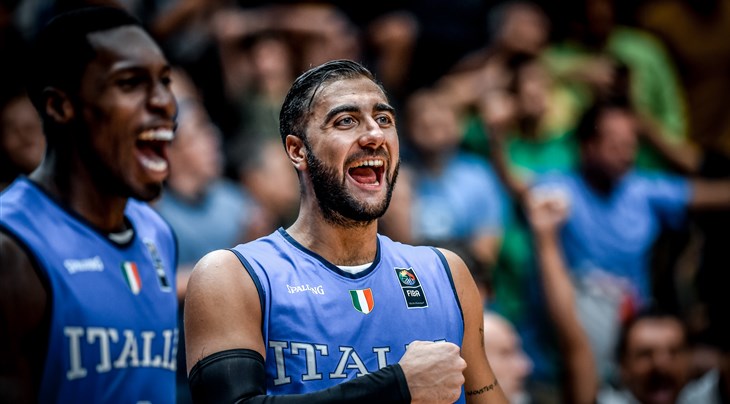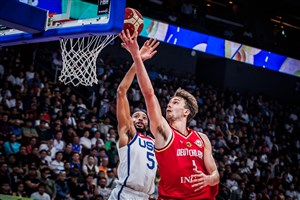
New FIBA World Ranking Men provides more accurate assessment
REGENSBURG (David Hein's Eye on the Future) - Coming up with a ranking is a pretty demanding task and one that can most times seem unforgiving since it almost only results in fans complaining about their teams' placing.
FIBA, however, seems to have come up with a pretty thoroughly analysed and well thought out new FIBA World Ranking Men, presented By Nike, which over the long haul will provide a more accurate assessment of countries' places in the world of basketball. This new rankings system is really a vast improvement on its predecessor, and there is quite a lot of research that went into it.
You can view the full ranking here, find out how it works here and check out the Frequently Asked Questions (FAQ) here.
New FIBA World Ranking Men presented by Nike launched https://t.co/MxR4YejSb8
— JEFF TAYLOR (@JeffreyNTaylor) October 11, 2017
First off, the timing of the new ranking was ideal since FIBA's new competition system tips off in just a few weeks. So fans will have a good idea where their countries rank in the game. This will also allow fans to see how their teams' ranking develops over the course of the qualifying campaign for the FIBA Basketball World Cup 2019 and the Continental Cups 2021. The ranking also includes 149 countries as opposed to the 91 in the previous system. One of the teams with the biggest move in the first new ranking is Italy - up 19 points to number 16 overall.
So, let's get into the meat of the new system a little and highlight some of the best points.
One good thing is that the ranking is calculated based on weighted game-by-game results in all national team competitions - ranging from FIBA regional level pre-qualifiers all the way to the FIBA Basketball World Cup Final. And that will be evaluated over an eight-year span.
Gilas Pilipinas dropped three places in the latest FIBA World Ranking. Despite that, they remained in Asia's top five, even ahead of Korea. pic.twitter.com/CFYqQlmrR1
— PBAonTV5 (@PBAonTV5) October 12, 2017
The ranking takes into account performances home and away and weighted point differentials in wins and losses. So winning by 11 points on the road is in general worth more than a victory at home by 2 points. But there is also an appropriately weighted level of competition factor incorporated as well. This means that, as an example, beating Korea in Korea and winning in Bahrain do not have the same value of victories.
The stage of the competition in which the game is played also determines the number of points gained from it. A triumph in the Semi-Finals of the FIBA AmeriCup is weighted higher than a win in the Group Phase of FIBA AfroBasket - with neither game receiving any factor in terms of home and away games since they are played on a neutral court.
Complete list of African countries in the new @FIBA @Nike men's world rankings. @NigeriaBasket holds onto the top spot in Africa. pic.twitter.com/SbQJc6lHux
— Coach Liz Mills (@Coach_LizMills) October 12, 2017
And actually a victory in a FIBA Americas competition is weighted more than a win in Africa since the regions are also weighted differently - Europe being the strongest at the continental level, followed by Americas with Africa being the lowest rated region. The new ranking has pushed the FIBA Basketball World Cup slightly ahead of the Olympic Basketball Tournament in weight - from being even at a level of 5.0 in the old system to the World Cup being 2.5 and the Olympics 2.0 in the new rankings.
As previously, the new ranking stretch out over eight years. But the interesting dynamic featured in the new ranking is a time decay factor, rewarding teams for most recent performances. The results this year and the previous year have a full value of 1.0 while performances from two and three years back are weighted at 0.75, the next two years back at 0.50, and six and seven years back at 0.25. This would allow, for example, a country to move back up in the rankings after a string of poor showings over a year or two. And it still rewards countries for remaining consistent throughout the two Olympic cycles.
All those mathematical equations to calculate the ranking are too much for those who are a bit less numbers orientated - such as yours truly. But if the masterminds behind the FIBA World Ranking Men, presented by Nike, have crossed all their t's and dotted their i's, then it sounds like the ranking will be very accurate - much more than in the past.
David Hein
FIBA
FIBA's columnists write on a wide range of topics relating to basketball that are of interest to them. The opinions they express are their own and in no way reflect those of FIBA.
FIBA takes no responsibility and gives no guarantees, warranties or representations, implied or otherwise, for the content or accuracy of the content and opinion expressed in the above article.
















